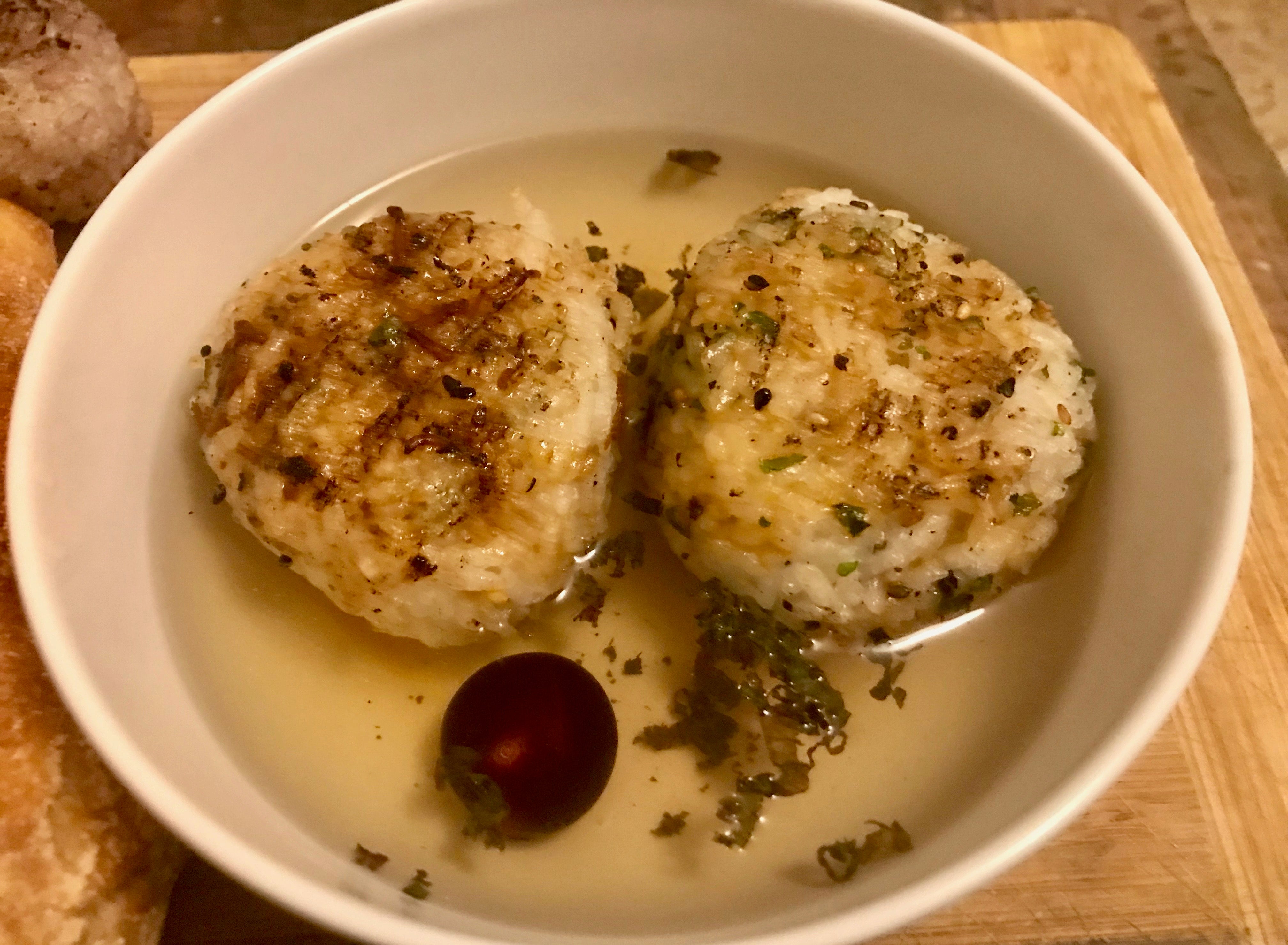お茶漬けという日本料理を食べたことがありますか?お茶漬けは、海外の日本食レストランではあまり見かけません。むしろ、家庭で楽しまれる、家族で愛される伝統的な料理です。人気日本のアンソロジードラマ『深夜食堂』でお茶漬けを見たことがあるかもしれません。このドラマでは、シンプルな日本の家庭料理が数多く登場し、3人の女友達(彼女たちがお茶漬け姉妹と呼ばれているのはそのためです)の定番のおやつとしてお茶漬けが登場します。
お茶漬けは、その名の通り、ご飯にお茶を注いだ料理です。一般的には、煎茶、番茶、ほうじ茶など、日本茶が使われます。近年では、好みに合わせて、あるいは家庭にあるものでお茶漬けを楽しむ人も増えています。お湯、冷たい麦茶、スープ、だしなど、これらはすべてお茶漬けと呼ばれています。今日は、お茶漬けとその歴史についてもう少し詳しくご紹介し、皆さんが自宅でお茶漬けを作ってみようというきっかけになれば幸いです。
お茶漬けの歴史
ご飯にお茶をかけて楽しむこの習慣は、江戸時代(1603~1868年)に始まったと言われています。しかし、お茶漬け(つまり、ご飯にお茶を注ぐこと)の起源は、日本で初めて稲作が始まった縄文時代(紀元前14,000~300年)にまで遡るようです。この時代は、狩猟採集と低強度の植物管理が組み合わさった時代でした。その後、本格的な農耕に移行し、水稲作も行われるようになりました。この時代、人々はご飯に熱湯や水をかけて食べていたと考えられています。証拠から、日本で少なくとも3,000年前から稲作が行われていたことが示唆されています。 『源氏物語』などの有名な日本の文学作品にも、湯漬けや水飯に関する記述があります。 『枕草子』( まくらそうし)によると、平安時代(794~1185年)にはお茶漬けが食べられていたようです。 「湯漬け」はご飯に熱湯をかけ、 「水飯」はご飯に水をかけることを指します。当時はご飯の熱を魔法のように保つ炊飯器などありませんでしたので、ご飯は冷めてパサパサになってしまうのは当然のことでした。そのため、人々はご飯の温かさと水分を保つために、自然に熱湯や水をかけてご飯を炊くようになったのです。
では、日本人がご飯にお茶をかけるようになったのはいつからでしょうか?日本茶の歴史に詳しい方なら、「江戸時代」と答えたのではないでしょうか。まさにその通り! 正確には、番茶や煎茶がより身近になり、庶民にも好まれるようになった江戸時代中期です。煎茶にはより多くのうま味が含まれていると言われていましたが、この時代は番茶をご飯にかけて食べるのが一般的でした。お茶漬けは、準備に時間も手間もかからず手軽に作れるため、貴族の家では使用人にとって非常に典型的な食事となりました。使用人たちが質素な食生活の中で自由に食べられるおかずは、基本的に漬物だけでした。そのため、彼らはお茶漬けの上に漬物を山のように(!)積み上げ、これが現代のお茶漬けの食べ方に大きな影響を与えたと言われています。
そして、時代が進むにつれて、お茶漬けには梅干しや海苔、鮭、たらこなど様々なトッピングが加えられるようになり、お茶漬けはますます多くの人に親しまれるようになりました。江戸時代、一般的に米を炊くのは1日1回。朝は温かいご飯を、夜は残ったご飯を温かいお茶漬けにして食べていました。江戸時代の最盛期(元禄時代)には、茶漬け屋と呼ばれる飲食店が開業し、庶民のファストフードとしてお茶漬けが楽しまれるようになりました。この時代に、手軽で便利な食事や冷めてしまったご飯の消化手段としてお茶漬けが人気を博したのです。また、お茶漬けは農家の米を一粒残らず食べることができるため、稲作農家の苦労に感謝し、感謝の気持ちを表すものだったことも特筆すべき点でしょう。
インスタントお茶漬け
1952年、食品会社である永谷園が世界初のインスタントお茶漬けの販売を開始しました。日本に住んだことがある方、あるいは日本を訪れたことがある方なら、スーパーマーケットやコンビニエンスストアで手軽にお茶漬けが手に入るのを目にしたことがあるかもしれません。あるいは、この有名なインスタントお茶漬けを口にしたことがあるかもしれません。
 実はこれ、家に一つあったんです!パンデミック中に再会した大学時代の親友がアメリカから送ってくれたんです(見ての通り、パッケージには英語が書いてあります)。これは梅干し味です。
実はこれ、家に一つあったんです!パンデミック中に再会した大学時代の親友がアメリカから送ってくれたんです(見ての通り、パッケージには英語が書いてあります)。これは梅干し味です。
基本的に、ご飯(日本の家庭ではご飯が余るのはよくあることです)とお湯があれば大丈夫です。インスタントお茶漬けの袋の中身をご飯の上に注ぎ、お湯を注ぐだけで、出来上がり!お茶漬けの出来上がりです。
見た目は緑茶のようですが、出汁が入っているので実は塩辛いんです。はい!上質な日本茶で作ると全く違う味になりますが…インスタントバージョンなら、お茶漬け自体に風味があるので、付け合わせを用意する必要はありません。材料は一般的に乾燥海苔、あられ(この場合はとても小さな米のパフ/クラッカーです)、塩、緑茶パウダーで、フレーバーによってはフリーズドライサーモン、梅干し、わさびなどが加えられることもあります。最近では永谷園以外にも各社が独自のお茶漬けを販売しており、日本各地で様々な種類のお茶漬けが見つかるでしょう。Yunomiではわさびのお茶漬けも販売しています!
今日のお茶漬け
今日でも、お茶漬けは心安らぐ簡単に作れる食事であり続けています。インスタントの袋入りのもの以外にも、お茶漬けの楽しみ方は様々です。液体のベースとしてお湯を好む人もいれば、お茶、抹茶を試す人もいます。お茶漬けを出す店では、その店独自の自家製つゆで出すこともあります。地域によっても違いがあります。静岡県はうな茶と呼ばれる焼きうなぎをトッピングしたお茶漬けで有名で、京都ではぶぶ漬けとして知られています。京都では、主人がぶぶ漬けを食べませんかと尋ねたら、そろそろ帰る時間だと微妙に告げている可能性があると昔から言われています。しかし、それが今日でも本当なのか、あるいは過去においても本当だったのかどうかは実はかなり曖昧です。京都地方はまた、ぶぶ漬けの素晴らしいトッピングとなる野生の野菜の漬物でも有名です。実は、漬物の種類や作り方は各家庭によって異なり、江戸時代の先祖伝来の漬物作りを今も受け継いでいる家庭もあります。京都を訪れる機会があれば、有名な漬物店で旬の野菜を10種類以上も詰め合わせたぶぶ漬けを楽しむのも良いでしょう。
それがお茶漬けです!地域によって違いがあり、微妙な意味を持つ、とても古い家庭料理です。お気に入りのお茶漬けがあれば、ぜひ教えてください。最後に、私の個人的なお茶漬けのおすすめを一つお伝えしたいと思います。東京の両親の近所にある居心地の良い焼き鳥屋には、焼きおにぎり茶漬けがあり、これは焼いたおにぎりが入ったお茶漬けで、とても美味しいです!私たちは実際にフランスでそれをグリルで作ってみました。基本的には、ご飯にお茶を注ぐ代わりに、まず焼きおにぎりを作りますが、これも古代の方法です。考古学者は、2000年前のおにぎりの焦げた残骸を発見しました!おにぎりを作ったことがない方は、柔らかくて粘り気のある食感の日本米(寿司を作るのと同じ短粒種の米)を使用するのが最適です。
 醤油ベースのタレで焼くだけのおにぎり。ご飯にふりかけ(シソ、昆布、ゴマなど)をかけて、彩りと風味をプラスしました。
醤油ベースのタレで焼くだけのおにぎり。ご飯にふりかけ(シソ、昆布、ゴマなど)をかけて、彩りと風味をプラスしました。
おにぎりの中には、焼き鮭、梅干し、味付け海苔など、普段おにぎりに入れる具材を何でも入れることができます。もちろん、おにぎりを焼く必要はありません。でも、個人的には焼くことをお勧めします。焼くことでおにぎりの外側がカリッとした食感になり、おにぎりの中身やお茶漬け、スープの素ととてもよく合うからです。おにぎりを焼く際に、醤油、料理酒、みりん(米酒の一種)、砂糖シロップなどを混ぜたものを外側に塗って風味をプラスするのも良いでしょう。
 グリルでおにぎり!
グリルでおにぎり!
おにぎりが完成したら、おにぎりを一つ(お腹が空いていれば二つでも!)椀に入れ、お好みで海苔やシソなどを添えます。最後に、お好みの日本茶を注いで温かいうちに召し上がってください。もちろん、夏なので冷たいお茶がお好みなら、それもアリです。私たちは夕方に作ったので、その日の釜炒り茶(宮崎茶房園)の4煎目を注ぎました。完璧な日本の材料が揃っていなかったかもしれませんが、この焼きおにぎり茶漬けの出来栄えには満足しています…どうぞ召し上がってください!


注目の画像:家にあるものでお茶漬けを作る。残った玄米の上に、イワシ(生姜で焼いて即席のかば焼き風にしたもの)と紫蘇の乾燥フレークをトッピング。選んだお茶は? 武雄茶園の番茶。写真:ジミー・バーリッジ


